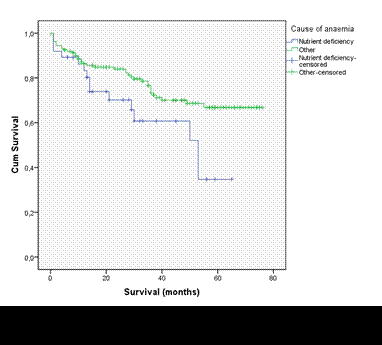Abstract
Macrocytic anaemia (MCV ≥ 100 fl) is regularly encountered in general practice and in hospital settings. However, the incidence of macrocytic anaemia in newly diagnosed patients remains elusive. In addition, factors influencing laboratory diagnosis and prognosis are unclear. PAGAS (Project of Anaemia from the General practitioner to the Albert Schweitzer hospital) is a collaboration of 63 general practitioners and the Albert Schweitzer hospital (Dordrecht, the Netherlands), which aims at improving quality of care for anaemic patients. We set out to clarify the incidence of newly discovered macrocytic anaemia in the PAGAS cohort and to determine the underlying causes of macrocytic anaemia.
Anaemia was defined as a haemoglobin level below 13.7 g/dL for men and below 12.1 g/dL for women. These values were used for persons older than 16 years. Patients who were included in the PAGAS study had to present to their general practitioner with a newly diagnosed anaemia i.e. no known anaemia in the preceding two years. Women were included when aged 50 years or older, in order to prevent an overabundance of iron deficiency anaemia (IDA) due to hypermenorrhea. Men were included when aged 17 or older. Patients were included between the 1st of February 2007 and the 1st of February 2013. For each patient an extensive laboratory work-up was performed, considering a broad range of causes of anaemia. Furthermore all additional hospital work-up was analyzed as well, including bone marrow examinations and a report of alcohol abuse when present.
A classification system was developed that included the following causes: 1) anaemia of chronic disease (ACD 2) haemolysis 3) bone marrow disease 4) vitamin B12 deficiency 5) folic acid deficiency 6) iron deficiency 7) reported alcohol abuse 8) renal anaemia and 9) other. If no cause could be established, it was classified as unknown. The cause of each anaemia was established by 2 independent observers. In case of a discrepancy, the observers deliberated until a consensus was reached.
Over the span of 6 years a total of 2738 patients were included in the PAGAS study. 190 (6,9%) of these 2738 patients presented with a macrocytic anaemia; 108 men (56,8%) and 82 (43,2%) women. Men were aged 70,7 years on average at the time of inclusion while women had an average age of 79 years when included. In 83,7% of patients (N=159), the underlying cause of the anaemia could be established. Seven patients displayed a double underlying cause. Bone marrow disease was found 18 times (9,1%), vitamin B12 deficiency 27 times (13,7%), folic acid deficiency 10 times (5,1%), haemolysis 7 times (3,6%) and alcohol abuse 27 times (13,7%). In addition, we found 39 patients (19,8%) with ACD, 4 patients (2,0%) with IDA and 29 patients (14,7%) with renal anaemia. Five cases of anaemia (2,5%) were classified as other.
Overall survival was 57 months (95% CI 52,6-61,4) after entry into the study. The survival of patients with a nutrient deficiency, vitamin B12 or folic acid, was significantly shorter (41,8 months, 95% CI 33,2-50,3) when compared to the survival of the other patients in the cohort (58,3 months, 95% CI 53,7-63) (p-value = 0,024). See figure 1.
Significantly more alcohol abuse was found as a cause in the age group of 50-64 years (20 of 27 cases) compared to the other four age groups (17-49, 65-74, 75-84 and 85+ years) combined (p-value = 0,000). In addition, the number of cases of renal anaemia found in the combined 75-84 and 85+ age groups (27 of 29 cases) differed significantly when compared to the other three age groups combined (p-value = 0,000). Nutrient deficiency was observed more often in the two highest age groups combined (24 of 37 cases) when compared to the lower three combined but this difference was not significant (p-value = 0,165).
In our cohort study the well known causes of macrocytic anaemia – bone marrow disease, alcohol abuse, haemolysis and vitamin B12 and folic acid deficiency – were found in 45,2% of patients. However, ACD, IDA and renal anaemia, typically reported in normocytic and microcytic anaemic patients, were leading causes of anaemia in 36,5% of patients.
As shown in our population the causes of macrocytic anaemia are diverse. Therefore we consider a broad diagnostic work-up warranted to completely elucidate the underlying cause.
No relevant conflicts of interest to declare.
Author notes
Asterisk with author names denotes non-ASH members.


This feature is available to Subscribers Only
Sign In or Create an Account Close Modal